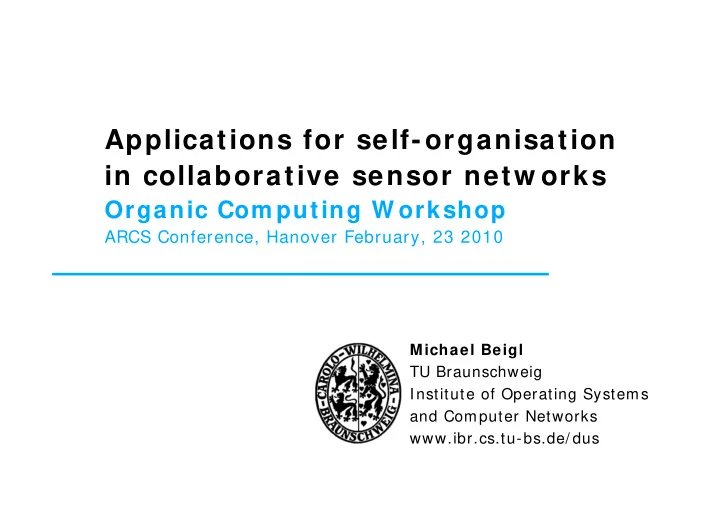

Applications for self-organisation in collaborative sensor netw orks Organic Com puting W orkshop ARCS Conference, Hanover February, 23 2010 Michael Beigl TU Braunschweig Institute of Operating Systems and Computer Networks www.ibr.cs.tu-bs.de/ dus
How do collaborative sensor network oApps look like I: A motivating example Collaborative Business Items (CoBIs) Michael Beigl S elf-organisation in Collaborative Sensor Networks 2
How do collaborative sensor network oApps look like I: Motivating example Supported ? Business Chemical-Containers Processes Real-time Process Relocated at BP equipped with Data (U1) Process Tasks (U2) Control (U3) sensor nodes Service 1 … Service n Service 2 MANY types of Service 4 Service 3 Service Proxy Layer self-organization in a system Physically Embedded System Real-time channel access Organizing the collaboration of sensor nodes, heterogonous collaboration Reasoning about faults, failures, errors ▫ Backend reasons about critical conditions, provides new rules for middleware and sensor nodes Michael Beigl S elf-organisation in Collaborative Sensor Networks 3
How do collaborative sensor network oApps look like II: Tools Software Defined Radio Michael Beigl S elf-organisation in Collaborative Sensor Networks 4
How do collaborative sensor network oApps look like II: Tools & Apps Coherent transmission: collaboration to self-organize a set of nodes that sing together like a chorus Application: Field deployed wireless sensor networks Non-Coherent transmission: collaboration to self- organize a set of nodes e.g. to process data on the channel Application RELATE Michael Beigl S elf-organisation in Collaborative Sensor Networks 5
How do collaborative sensor network oApps look like III: The RELATE example EU Projekt RELATE Michael Beigl S elf-organisation in Collaborative Sensor Networks 6
Motivation: Distributed Map for Fireman EU Projekt Goal RELATE Replacement of „Lifeline“ for fireman System: Determine position of fireman with best possible accuracy Method Automatically drop sensor nodes in a building Sensor nodes measures and communicate distance peer to peer Dynamic Several fireman work in parallel in one building ▫ High node density, area coverage Sensor nodes operate in harsh environment ▫ Disturbance, destruction of nodes Michael Beigl S elf-organisation in Collaborative Sensor Networks 7
RELATE: Distributed Map creation Problem High measurement error (systematic, statistical) Communication errors, noise Highly dynamic setting, no stable set of nodes Sensor node tasks Measure Distance to other nodes Result: Estimation of Distance Receive estimations from other nodes Distribute Distances Calculate new distances (Average) Show result to end user Michael Beigl S elf-organisation in Collaborative Sensor Networks 8
Properties RELATE sensor networks Properties Self-optimizing the local view: ask neighbors , build collective view Converts systematic to a statistical error with Gaussian distribution Degree of self-optimization depends on time, energy, conditions and # of nodes Problem : Don’t trust anybody : Quality of distances differs Michael Beigl S elf-organisation in Collaborative Sensor Networks 9
RELATE Distance Measurement All measurement values are error prone Resulting fusion problem: Instead of improvement we might worsen the result But errors follow a certain pattern, e.g. correlate to type of sensor, sensor node, context etc. Solution: Selforga + Context-awareness Additional contextual values while measurement Annotate distance and context/value pairs Rate quality of measurement according to actual context, history Fusion/calculation of distances uses quality measurement Michael Beigl S elf-organisation in Collaborative Sensor Networks 10
Model of RELATE Sensor Node Communication Quality Decision Distance and quality Estimation History Sensory Measure distance Fused List of Quality Estimation Distances Distances Estimation based on Communicatio Measurement context, self-aware n s Decision RELATE-Sensor Node Fuse distances considering quality estimation List of Distances Quality values and distances Problem Very complex system in one node Even more complex when looking at several nodes Michael Beigl S elf-organisation in Collaborative Sensor Networks 11
Tool: Blackboard Implementation All modules communicate via Blackboard Modules are local or remote (simulated) Time is real or virtual, allows to follow progress Blackboard console as debugging tool Blackboard Manager Blackboard Manager notify monitor notify monitor coop. read read Blackboard Blackboard Program Program write write Modules Modules OS Access OS Access OS Access OS Access Operating System e.g PC Operating System e.g Sensor Node Communication Michael Beigl S elf-organisation in Collaborative Sensor Networks 12
Superimposing Signals: Collaborative Communication Problem: We need to send n² packets to compute weighted sums Solution: Use channel to compute weighted sum O(n²)->O(n) Collaborative Signaling Michael Beigl S elf-organisation in Collaborative Sensor Networks 13
1: Analog Network Coding Principle: Use (analog) coding on the channel to transfer information collaboratively Robust against errors Reduction of Energy consump. Up to 1000x Real-time wireless communcation Michael Beigl S elf-organisation in Collaborative Sensor Networks 14
2: processing on the channel E.g. operations „Or“, „Average“, „Weighted Avg“ Priciple: Transmission of extremly short, overlaying signals Interpretation using estimation s=32, ß=0.9 Michael Beigl S elf-organisation in Collaborative Sensor Networks 15
More oApp‘s: Context Phone Detecting situations and activities Michael Beigl S elf-organisation in Collaborative Sensor Networks 16
More oApp‘s: Context Phone Detecting situations and activities How to self-modify, extend classification without re-training? 1) novel learning approach 2) collaborate with systems smarter than you Michael Beigl S elf-organisation in Collaborative Sensor Networks 17
Conclusion Organic Com puting m ethods help to efficiently im plem ent features for com puting system s Avoids specification of too many possible conditions Provides robustness in case of errors, failures, faults Allows heterogeneous integration of knowledge & functionality For im proved robustness in real-w orld settings, context and self-aw areness is helpful Tools are required to efficiently run com plex projects But tools are often specific to project Although re-use is thinkable and would be helpful Michael Beigl S elf-organisation in Collaborative Sensor Networks 18
Applications for self-organisation in collaborative sensor netw orks Thank you for your attention Michael Beigl TU Braunschweig Institute of Operating Systems and Computer Networks www.ibr.cs.tu-bs.de/ dus
Recommend
More recommend